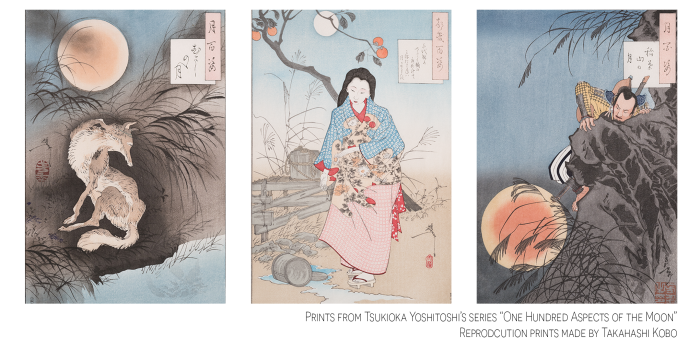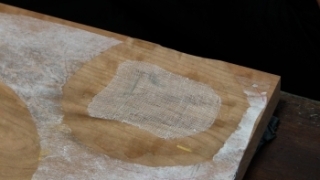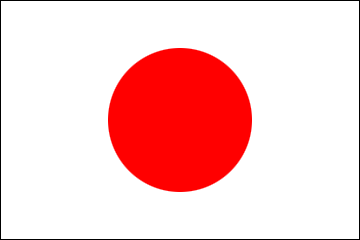Spotlight on... TAKAHASHI Yukiko of Takahashi Kobo, a 160-year-old ukiyo-e woodblock print workshop
2021/4/12
On 18 March, the Embassy hosted a webinar on the topic of ukiyo-e woodblock printing and the efforts that go into preserving the traditional techniques involved. TAKAHASHI Yukiko of Takahashi Kobo, a 160-year-old ukiyo-e woodblock print workshop based in Tokyo, joined Dr Alfred Haft of the British Museum to discuss the work of woodblock designer and artist TSUKIOKA Yoshitoshi (1839-1892) and the process of creating a reproduction of his famous series "One Hundred Aspects of the Moon".
Yoshitoshi’s career spanned a period in which woodblock printing gradually gave way to new forms of print technology such as lithography. Mrs Takahashi and Dr Haft discuss the significance of Yoshitoshi, explaining the unusual techniques uncovered during the reproduction of his work and revealing why he is known as one of the last great ukiyo-e artists.
Watch the webinar in full:
A large number of viewers put questions towards the speakers during the webinar but unfortunately due to time constraints, the guest speakers were unable to answer them all. However, Mrs Takahashi was able to answer a selection of questions:
From which type of wood are the blocks carved? How long do the blocks last?
Blocks for printing are traditionally cut from solid boards of mountain cherry - a durable wood with a fine grain that allows for detailed relief carving and is able to withstand the friction of multiple print runs in different colours of ink. Another defining feature of the mountain cherry is that it is less susceptible to warping and shrinkage caused by changes in humidity. To prepare the blocks, roughly-sawn mountain cherry that has dried for several years is dressed and then planed along the grain in three stages - rough, intermediate and a smooth finish - until both sides of the blocks are smooth. It depends on the number of times the blocks are used for printing but it goes without saying that the lines of the first print are sharper than the last print.
What was the usual fate of woodblocks after the print edition was complete. Were they archived?
During the Edo Period (1603-1868), the custom of archiving used woodblocks did not really exist. Nowadays, woodblocks are kept and preserved as highly-prized items but for limited print editions, the woodblocks are intentionally damaged so they cannot be used again.
 Are the blocks used in ‘100 Aspects of the Moon’ the original blocks from the Meiji Period owned by the publisher AKIYAMA Buemon? Are or these the blocks of one of the later reprints?
Are the blocks used in ‘100 Aspects of the Moon’ the original blocks from the Meiji Period owned by the publisher AKIYAMA Buemon? Are or these the blocks of one of the later reprints?
The woodblocks we are using for the restoration project are from a publisher who reproduced the woodblocks during Showa Period (1926-1989). As for the woodblocks collected by AKIYAMA Buemon, they are not in existence and it is assumed that they were destroyed or else repurposed for other works.
How many woodcut panels are made for one piece of art - for example of the project of ‘100 Aspects of the Moon’?
Most ukiyo-e prints use 5-6 woodblocks / work and the series ’One Hundred Aspects of the Moon’ is no exception. Famous works by Hokusai or Hiroshige also use the same number of woodblocks.
When Yoshitoshi was active, how many copies were made from a set of woodblocks before they wore out and printing was stopped?
For popular works, a minimum of 200 prints would be created. There are no records available to show how many prints were made of Yoshitoshi’s work.
How rare are complete collections of the prints? Do we know how many still exist?
There is one collector in Japan who has all 100 prints of the series ‘One Hundred Aspects of the Moon’.
Is it still possible to obtain the original types of pigments which were used originally? What medium is used to mix the pigments?
In principle, we use the same pigments used in Edo Period (1603-1868). However, some are now recognized as toxic and are replaced with newer materials. The pigments are mainly mineral-based. As you saw in the film, the printer mixes pigment with water to achieve the right colour. Achieving the right colour is an important part of the printer's work.
Did Yoshitoshi also use Prussian Blue (berurin-ai or bero-ai), as well and is it still used today?
Prussian Blue has been used during Yoshitoshi’s time and even today.
Why is rice paste (himenori) mixed with the pigments on the block when printing? There seem to be various different theories.
We use starch glue. By mixing the glue with the pigments on the block, it will give the pigments adhesiveness and is easier to transfer to the paper.
Is there a special kind of paper that is being used for ukiyo-e prints? Did the artists from the Edo period have their preferred paper made for their use? How does it compare to the paper used at that time?
The paper used for this project is called 'echizen kizuki housho' handmade by a ‘living national treasure’ (a highly skilled craftsperson or artist so designated by the Japanese government). The paper is made from mulberry fibres. The paper is strong and suitable for Edo Woodblock Printing - which uses many pigments on the paper. As a result the print is finished with bright colours and has a warm feeling with it. The paper we use for the woodblock print is the same since the Edo period (1603-1868). It is now becoming more difficult to that to obtain good quality handmade Japanese paper.
What do you mean by the sound of the baren tells you when the print is ready?
As you can hear in the film, there are unique sounds generated by rubbing baren on the paper. It is hard to explain but the well trained printer can tell how far the print is done by hearing the sounds.
I really enjoyed seeing the process of Takahashi Kobo. I’m fascinated by how the block carver remakes lines and areas which have worn away. Is there an ethical framework for how each block is approached? The status of the “original” block is transformed as a result, so where does authenticity lie?
The job of the carver is to faithfully reproduce the lines originally drawn by the artist. Through our restoration work, we carefully preserve the original lines and plane off the unnecessary parts.
How long does a print take to dry?
The pigments are soluble and therefore are quickly absorbed into the paper which dries in no time.
Yoshitoshi’s career spanned a period in which woodblock printing gradually gave way to new forms of print technology such as lithography. Mrs Takahashi and Dr Haft discuss the significance of Yoshitoshi, explaining the unusual techniques uncovered during the reproduction of his work and revealing why he is known as one of the last great ukiyo-e artists.
Watch the webinar in full:
A large number of viewers put questions towards the speakers during the webinar but unfortunately due to time constraints, the guest speakers were unable to answer them all. However, Mrs Takahashi was able to answer a selection of questions:
From which type of wood are the blocks carved? How long do the blocks last?
Blocks for printing are traditionally cut from solid boards of mountain cherry - a durable wood with a fine grain that allows for detailed relief carving and is able to withstand the friction of multiple print runs in different colours of ink. Another defining feature of the mountain cherry is that it is less susceptible to warping and shrinkage caused by changes in humidity. To prepare the blocks, roughly-sawn mountain cherry that has dried for several years is dressed and then planed along the grain in three stages - rough, intermediate and a smooth finish - until both sides of the blocks are smooth. It depends on the number of times the blocks are used for printing but it goes without saying that the lines of the first print are sharper than the last print.
What was the usual fate of woodblocks after the print edition was complete. Were they archived?
During the Edo Period (1603-1868), the custom of archiving used woodblocks did not really exist. Nowadays, woodblocks are kept and preserved as highly-prized items but for limited print editions, the woodblocks are intentionally damaged so they cannot be used again.
 Are the blocks used in ‘100 Aspects of the Moon’ the original blocks from the Meiji Period owned by the publisher AKIYAMA Buemon? Are or these the blocks of one of the later reprints?
Are the blocks used in ‘100 Aspects of the Moon’ the original blocks from the Meiji Period owned by the publisher AKIYAMA Buemon? Are or these the blocks of one of the later reprints?The woodblocks we are using for the restoration project are from a publisher who reproduced the woodblocks during Showa Period (1926-1989). As for the woodblocks collected by AKIYAMA Buemon, they are not in existence and it is assumed that they were destroyed or else repurposed for other works.
How many woodcut panels are made for one piece of art - for example of the project of ‘100 Aspects of the Moon’?
Most ukiyo-e prints use 5-6 woodblocks / work and the series ’One Hundred Aspects of the Moon’ is no exception. Famous works by Hokusai or Hiroshige also use the same number of woodblocks.
When Yoshitoshi was active, how many copies were made from a set of woodblocks before they wore out and printing was stopped?
For popular works, a minimum of 200 prints would be created. There are no records available to show how many prints were made of Yoshitoshi’s work.
How rare are complete collections of the prints? Do we know how many still exist?
There is one collector in Japan who has all 100 prints of the series ‘One Hundred Aspects of the Moon’.
Is it still possible to obtain the original types of pigments which were used originally? What medium is used to mix the pigments?
In principle, we use the same pigments used in Edo Period (1603-1868). However, some are now recognized as toxic and are replaced with newer materials. The pigments are mainly mineral-based. As you saw in the film, the printer mixes pigment with water to achieve the right colour. Achieving the right colour is an important part of the printer's work.
Did Yoshitoshi also use Prussian Blue (berurin-ai or bero-ai), as well and is it still used today?
Prussian Blue has been used during Yoshitoshi’s time and even today.
Why is rice paste (himenori) mixed with the pigments on the block when printing? There seem to be various different theories.
We use starch glue. By mixing the glue with the pigments on the block, it will give the pigments adhesiveness and is easier to transfer to the paper.
Is there a special kind of paper that is being used for ukiyo-e prints? Did the artists from the Edo period have their preferred paper made for their use? How does it compare to the paper used at that time?
The paper used for this project is called 'echizen kizuki housho' handmade by a ‘living national treasure’ (a highly skilled craftsperson or artist so designated by the Japanese government). The paper is made from mulberry fibres. The paper is strong and suitable for Edo Woodblock Printing - which uses many pigments on the paper. As a result the print is finished with bright colours and has a warm feeling with it. The paper we use for the woodblock print is the same since the Edo period (1603-1868). It is now becoming more difficult to that to obtain good quality handmade Japanese paper.
What do you mean by the sound of the baren tells you when the print is ready?
As you can hear in the film, there are unique sounds generated by rubbing baren on the paper. It is hard to explain but the well trained printer can tell how far the print is done by hearing the sounds.
I really enjoyed seeing the process of Takahashi Kobo. I’m fascinated by how the block carver remakes lines and areas which have worn away. Is there an ethical framework for how each block is approached? The status of the “original” block is transformed as a result, so where does authenticity lie?
The job of the carver is to faithfully reproduce the lines originally drawn by the artist. Through our restoration work, we carefully preserve the original lines and plane off the unnecessary parts.
How long does a print take to dry?
The pigments are soluble and therefore are quickly absorbed into the paper which dries in no time.
 Nunomezuri
Nunomezuri
What is the purpose of embossing the textile weave? It is traditional?
It is based on tradition. Nunomezuri will bring the depth and fun to the work
How do they stop the texture of the cloth from spreading around the square area?
To stop any spreading, the part using the fabric is carved into a convex shape.
What are the primary differences between ukiyo-e of the Meiji period and that of shin-hanga?
Up until the Meiji period began in 1868, ukiyo-e woodblock printing functioned like a cultural publication which depicted the scenes of daily life. On the other hand, the contrast is that shin-hanga pursues artistic expression rather than the function.
Were normal ‘shomin’ able to buy those prints at that time? Or were they only for rich merchants and dealers selling to abroad?
During the Edo period (1603-1868), ukiyo-e was an essential part of everyday life for the general public. The price of ukiyo-e was affordable. Edo Woodblock Printing is now treated as pieces of art. Woodblock printing is appreciated across the world as a depiction of the Japanese aesthetic quality.
Will there be any ukiyo-e exhibitions in the UK in the near future?
I would very much hope to have the opportunity to bring and show the works to UK people when the situation allows.
Restoration can be quite 'invasive', involving selective cutting away of the original blocks? Is there an alternative view that one should instead leave these blocks in their original condition?
In the Edo Period, it was customary to reuse the woodblock by planing the surface. Nowadays, depending on the situation, there are occasions when the used woodblocks may be preserved.
How long does it take to repair the ukiyo-e? What is the most difficult thing to repair?
It depends on the damage. Old woodblocks may split, crack, warp or worst of all be damaged by worms. The damage caused by worms is very difficult to repair.
In the West, it is often said that ukiyo-e is the origin of manga. What do you think?
The original drawings called 'Chōjū Jinbutsu Giga' dates back to the 12th and 13th centuries. It is a famous artwork with frogs and rabbits moving around like human beings. There are various theories as to the origin of manga. But the general view is the old work such as 'Chōjū Jinbutsu Giga' and ukiyo-e woodblock prints are the origin of manga.
It is based on tradition. Nunomezuri will bring the depth and fun to the work
How do they stop the texture of the cloth from spreading around the square area?
To stop any spreading, the part using the fabric is carved into a convex shape.
What are the primary differences between ukiyo-e of the Meiji period and that of shin-hanga?
Up until the Meiji period began in 1868, ukiyo-e woodblock printing functioned like a cultural publication which depicted the scenes of daily life. On the other hand, the contrast is that shin-hanga pursues artistic expression rather than the function.
Were normal ‘shomin’ able to buy those prints at that time? Or were they only for rich merchants and dealers selling to abroad?
During the Edo period (1603-1868), ukiyo-e was an essential part of everyday life for the general public. The price of ukiyo-e was affordable. Edo Woodblock Printing is now treated as pieces of art. Woodblock printing is appreciated across the world as a depiction of the Japanese aesthetic quality.
Will there be any ukiyo-e exhibitions in the UK in the near future?
I would very much hope to have the opportunity to bring and show the works to UK people when the situation allows.
Restoration can be quite 'invasive', involving selective cutting away of the original blocks? Is there an alternative view that one should instead leave these blocks in their original condition?
In the Edo Period, it was customary to reuse the woodblock by planing the surface. Nowadays, depending on the situation, there are occasions when the used woodblocks may be preserved.
How long does it take to repair the ukiyo-e? What is the most difficult thing to repair?
It depends on the damage. Old woodblocks may split, crack, warp or worst of all be damaged by worms. The damage caused by worms is very difficult to repair.
In the West, it is often said that ukiyo-e is the origin of manga. What do you think?
The original drawings called 'Chōjū Jinbutsu Giga' dates back to the 12th and 13th centuries. It is a famous artwork with frogs and rabbits moving around like human beings. There are various theories as to the origin of manga. But the general view is the old work such as 'Chōjū Jinbutsu Giga' and ukiyo-e woodblock prints are the origin of manga.

